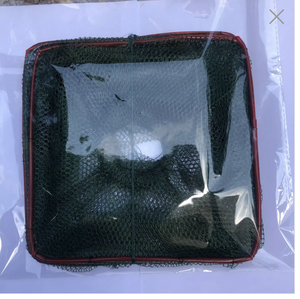(1117 products available)










































































































































































































A live bait net is usually used by fishermen to catch and store live bait for fishing. They come in various types, each designed for a specific purpose or fishing technique. Here is a look at some common types of live bait nets:
Scoop Nets
These are dip nets that have a shallow, round, or square net made with fine mesh. Usually, the mesh encloses the metal or plastic hoop attached to a long handle. Fishermen use scoop nets to catch small fish, minnows, and other types of live bait in ponds, tanks, and shallow waters.
Cast Nets
Cast nets are circular nets with weights around the edges. When thrown in water, the nets spread out and sink to trap live bait. Cast nets are used to catch schooling bait fish like shad, herring, or sardines in deeper waters.
Trout Bait Nets
These are small, fine mesh nets specifically designed to catch and handle trout without harming them. They usually have a soft mesh that prevents injury to the delicate skin of trout. This makes trout bait nets popular among anglers who fish for trout using live bait.
Fyke Nets
Fyke nets are baited trap nets that are used as a passive live bait fishing gear. They are usually set up in the water for a long time to catch and hold live bait fish. Fyke nets consist of cylindrical net cages made with mesh and wooden or metal hoops. They have funnel-shaped openings that allow fish to enter the cages but make it difficult for them to escape. They are used to catch larger quantities of live bait.
Landing Nets
Landing nets are large scoop nets that catch fish. They are commonly used by anglers to lift fish out of water after they have been hooked. Typically, a landing net has a telescopic handle that can be adjusted to the desired length. This makes landing nets suitable for different types of fishing situations and species.
Live bait nets are crucial tools for anglers and fishermen who rely on live bait for fishing. They are primarily used to catch, transport, and store live baits. Here are some application scenarios of live bait nets:
Live Bait Fishing
Fishing with live bait is the primary use of bait fishing nets. Anglers catch bait fish like minnows, shad, and shrimp with the help of these nets. They use these fish to lure larger game fish.
Bait Fish Farms
Bait fish farmers use live bait nets to harvest and handle bait fish. They ensure minimal stress and damage to the fish, which is essential for maintaining their quality and health.
Fish Hatcheries
Live bait nets are used in fish hatcheries to sort, transfer, and collect juvenile fish. The nets' gentle mesh helps to protect the young fish, which are more vulnerable to injury.
Fishing Charters and Guides
Fishing charter services use live bait nets to catch and supply live baits for their clients. They make sure that their clients have the necessary tools to enjoy the live bait fishing experience.
Emergency Fish Transportation
Live bait nets are used by aquarists and fish dealers to temporarily catch and transport fish during emergency situations, such as water quality crises or equipment failures.
Educational Purposes
Live bait nets are used by schools, camps, and educational organizations to teach children and students about fishing, aquatic ecosystems, and live bait fishing. The nets provide a hands-on learning experience that is safe and enjoyable.
Research and Conservation
Live bait nets are used by scientists and researchers to catch and study aquatic species. They conduct population surveys and ecological studies. The nets are also used for conservation projects to monitor and protect endangered aquatic species.
Choosing the right live bait net is an important factor for anglers who want to catch fish with a hook. Here are some factors to consider when selecting a bait net.
Q: What are the different types of live bait nets?
A: The three main types of live bait nets are cast nets, dip nets, and scoop nets. Cast nets are round with weights around the edge and are thrown over the water to trap bait fish. Dip nets have a deep, pocket-like netting for catching live baits, while scoop nets are designed for catching small fish by scooping them up from the water.
Q: How does one choose the right live bait net?
A: Choosing the right live bait net depends on factors such as the type of bait, fishing method, and net size and mesh. Consider the material and construction for durability and reliability.
Q: How does one maintain and store live bait nets?
A: To maintain live bait nets, rinse them with fresh water to remove salt and debris, air dry them to prevent rust and mildew, and store them in a dry, cool place away from direct sunlight. Inspect the nets regularly and repair any damages as needed.
Q: Can live bait nets be used for catch-and-release fishing?
A: Yes, live bait nets can be used for catch-and-release fishing. Dip and scoop nets are ideal for this purpose as they have soft mesh materials that minimize damage to the fish. Using the right net for catch-and-release fishing ensures the fish's survival and sustainability of the fishery.